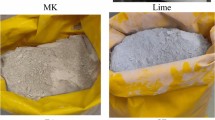The results of research on the compositions of ceramic bodies using different pore-forming components to obtain wall ceramic materials with improved heat-insulation characteristics are presented. It is found that they have a positive effect on the properties and structure of ceramic building materials.



Similar content being viewed by others
Notes
Here and below the weight content of the component is presented, %.
References
G. V. Lisachuk, L. P. Shchukina, V. V. Tsovma, et al., “Assessment of clayey raw material suitability for wall and facade ceramic production,” Steklo Keram., No. 3, 14 – 19 (2013); G. V. Lisachuk, L. P. Shchukina, V. V. Tsovma, et al., “Assessment of clayey raw material suitability for wall and facade ceramic production,” Glass Ceram., 70(3 – 4), 89 – 92 (2013).
A. V. Kornilov, “Reasons for the different effects of alcareous clays on strength properties of ceramics,” Steklo Keram., No. 12, 30 – 32 (2005); A. V. Kornilov, “Reasons for the different effects of alcareous clays on strength properties of ceramics,” Glass Ceram., 62(11 – 12), 391 – 393 (2005).
I. G. Dovzhenko, “Light-tone ceramic facing brick manufacture using ferrous-metallurgy by-products,” Steklo Keram., No. 8, 11 – 13 (2011); I. G. Dovzhenko, “Light-tone ceramic facing brick manufacture using ferrous-metallurgy by-products,” Glass Ceram., 68(7 – 8), 247 – 249 (2011).
V. Yu. Meleshko, “Some aspects of the development of the manufacture and utilization of hollow-body porisized blocks,” in: Reports and Communications of an International Seminar on Scientific and Technical Problems of the Production and Enhancement of the User Properties of Building Materials and Articles [in Russian], NIISM, Minsk (2004), pp. 44 – 49.
A. M. Salakhov, V. P. Morozov, and G. R. Tuktarova, “Upgrade of production technology of building ceramics and expansion of product range,” Steklo Keram., No. 3, 18 – 21 (2005); A. M. Salakhov, V. P. Morozov, and G. R. Tuktarova, “Upgrade of production technology of building ceramics and expansion of product range,” Glass Ceram., 62(3 – 4), 80 – 83 (2005).
N. G. Gurov, L. V. Kotlyarov, and N. I. Ivanov, “Production of tinted ceramic brick from red-burning clay raw materials,” Stroit. Mater., No. 9, 58 – 59 (2005).
A. V. Kornisov and A. F. Shamseev, “Production of hollow-body porous ceramic brick from mineral raw material in the Republic of Tatarstan,” Stroit. Mater., No. 7, 2 – 4 (2003).
Author information
Authors and Affiliations
Corresponding author
Additional information
Translated from Steklo i Keramika, No. 2, pp. 19 – 23, February, 2015.
Rights and permissions
About this article
Cite this article
Pishch, I.V., Biryuk, V.A., Klimosh, Y.A. et al. Properties of Ceramic Wall Materials with Different Burnable Components. Glass Ceram 72, 57–60 (2015). https://doi.org/10.1007/s10717-015-9723-5
Published:
Issue Date:
DOI: https://doi.org/10.1007/s10717-015-9723-5




